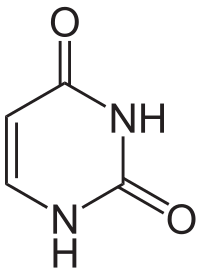
Photo from wikipedia
Doubly and triply hydrogen-bonded supramolecular synthons are of particular interest for the rational design of crystal and cocrystal structures in crystal engineering since they show a high robustness due to… Click to show full abstract
Doubly and triply hydrogen-bonded supramolecular synthons are of particular interest for the rational design of crystal and cocrystal structures in crystal engineering since they show a high robustness due to their high stability and good reliability. The compound 5-methyl-2-thiouracil (2-thiothymine) contains an ADA hydrogen-bonding site (A = acceptor and D = donor) if the S atom is considered as an acceptor. We report herein the results of cocrystallization experiments with the coformers 2,4-diaminopyrimidine, 2,4-diamino-6-phenyl-1,3,5-triazine, 6-amino-3H-isocytosine and melamine, which contain complementary DAD hydrogen-bonding sites and, therefore, should be capable of forming a mixed ADA-DAD N-H...S/N-H...N/N-H...O synthon (denoted synthon 3sN·S;N·N;N·O), consisting of three different hydrogen bonds with 5-methyl-2-thiouracil. The experiments yielded one cocrystal and five solvated cocrystals, namely 5-methyl-2-thiouracil-2,4-diaminopyrimidine (1/2), C5H6N2OS·2C4H6N4, (I), 5-methyl-2-thiouracil-2,4-diaminopyrimidine-N,N-dimethylformamide (2/2/1), 2C5H6N2OS·2C4H6N4·C3H7NO, (II), 5-methyl-2-thiouracil-2,4-diamino-6-phenyl-1,3,5-triazine-N,N-dimethylformamide (2/2/1), 2C5H6N2OS·2C9H9N5·C3H7NO, (III), 5-methyl-2-thiouracil-6-amino-3H-isocytosine-N,N-dimethylformamide (2/2/1), (IV), 2C5H6N2OS·2C4H6N4O·C3H7NO, (IV), 5-methyl-2-thiouracil-6-amino-3H-isocytosine-N,N-dimethylacetamide (2/2/1), 2C5H6N2OS·2C4H6N4O·C4H9NO, (V), and 5-methyl-2-thiouracil-melamine (3/2), 3C5H6N2OS·2C3H6N6, (VI). Synthon 3sN·S;N·N;N·O was formed in three structures in which two-dimensional hydrogen-bonded networks are observed, while doubly hydrogen-bonded interactions were formed instead in the remaining three cocrystals whereby three-dimensional networks are preferred. As desired, the S atoms are involved in hydrogen-bonding interactions in all six structures, thus illustrating the ability of sulfur to act as a hydrogen-bond acceptor and, therefore, its value for application in crystal engineering.
Journal Title: Acta crystallographica. Section C, Structural chemistry
Year Published: 2018
Link to full text (if available)
Share on Social Media: Sign Up to like & get
recommendations!